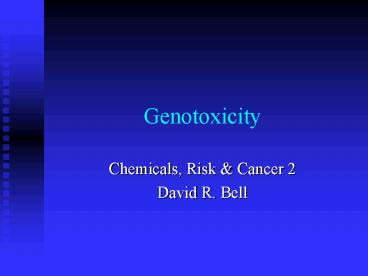Genotoxicity - PowerPoint PPT Presentation
1 / 22
Title:
Genotoxicity
Description:
maintain animals on the Maximum Tolerated Dose until the end of their lives or 2 ... MNU mutates codon 12, base 2, G-A in 100% of H-ras oncogene in mammary tumours ... – PowerPoint PPT presentation
Number of Views:276
Avg rating:3.0/5.0
Title: Genotoxicity
1
Genotoxicity
- Chemicals, Risk Cancer 2
- David R. Bell
2
Do chemicals cause cancer ?
- Dose animals with a chemical, or vehicle control
- maintain animals on the Maximum Tolerated Dose
until the end of their lives or 2 years - Kill animals, and necropsy
- Detailed account of tumour incidence
- DiMethylBenzAnthracene (DMBA from coal dust) was
found to give rise to cancer - Systematic investigation of chemicals which cause
cancer
3
Nitrosamines
- Cause cancer in mouse, rat, monkey, guinea-pig,
rabbit, fowl, newt, trout - Wide range of organs affected
- Formed in food in the presence of nitrate, and
acid, ie pickles - Potent
R1
N
NO
R2
4
Nitrosamines
O-H
CH2
CH3
Oxidation
N
NO
N
NO
CH3
CH3
The methyl carbonium ion is a powerful
electrophile, and reacts quickly with
macromolecules.
H2-CO
CH3-NN-OH
N2
CH3-N2
CH3
OH-
5
Electrophiles
- Chemical entities which react with centres having
a surplus of electrons, or nucleo-philes. - Protein, RNA and DNA contain nucleophilic sites
6
Electrophiles and DNA
H
CH3
H
CH3
..
O
O
N
N
N
N
N
N
N
N
H2N
H2N
dR
dR
Guanine
O6-methyl Guanine
7
Electrophiles and DNA 2
H
- There are multiple reactions of electrophiles
with DNA - O6 methyl guanine is promutagenic
- The alkylated base mispairs G-T, instead of G C
- This leads to inaccurate repair, and mutations in
DNA - N7-G also promutagenic
N7
O
N
N
N
N
H2N
Guanine
dR
8
Methylnitrosourea
CH3
NO
NH2CO2H
H2O
N
CH3-NH-NO
C
O
H2N
OH-
CH3-N?N
Electrophiles
CH3
N2
9
Genotoxicity
- Electrophiles react most with protein, then RNA,
then DNA- based on abundance - O6-Me dG read as dA during replication, and
mis-paired to dT - Leads to a G-A transition, or point mutant
- Toxicity to the genome- hence genotoxicity
10
Genotoxicity and cell division
- Cell division greatly enhances the mutagenic
effects of DNA alkylation
Two weeks promotion
3 hrs
7 days
Kill
Partial hepatectomy
MNU
11
Effect of cell division
12
Consequences of DNA alkylation
- Large amounts of endogenous methylation
- 5MeA, 6MeC
- Specific repair enzyme- O6 MeG methyltransferase
(MGMT) in mammalian cells - MGMT is induced by genotoxic carcinogens, or
radiation, i.e. DNA damage
13
MGMT
- MGMT removes O6-Methyl from O6MedG in a one-step
suicide reaction - No cofactors
- The Methyl group transfers to Cys145 of MGMT
- MGMT inactivated and rapidly degraded
- High cost to cell
14
Is MGMT important ?
- Overexpression of bacterial MGMT in cells makes
the cells resistant to MNU killing - Gene KO of MGMT makes mice sensitive to MNU in
terms of death, and cancer - MGMT-/-, MLH1 -/- mice remain sensitive to
MNU-induced tumours, but not to MNU induced
killing. - Mismatch repair of damaged DNA leads to cell death
15
DNA repair
- Methylnitrosourea (MNU) is a direct alkylating
agent - In rats, it has tissue-specificity, with
brain-specific tumorigenesis - DNA-adduct levels are similar in brain in liver
- Adducts are removed rapidly in liver, but persist
in brain
16
Consequences of mutation
- MNU mutates codon 12, base 2, G-A in 100 of
H-ras oncogene in mammary tumours - Codons 12, 13, 16, 59, 61, 116 activate Ras
- Specific sequences are particularly susceptible
to mutation - Specific sequences are refractory to repair
- Organ-specific effects on oncogene activation
17
DNA damage ? cancer
DNA damage is similar between the two
strains Tumour development is markedly
different Therefore other factors control the
development of cancer
18
DNA adducts
- Each alkylating agent produces a spectrum of
adducts - Measurement of adducts
- Which is the important adduct ?
- Very high levels of some endogenous adducts
(methyl, ethyl, estrogens, etc) - Adducts are repaired/ fixed
- What is important- the adducts remaining, or the
adducts which caused a mutagenic event ?
19
DNA adducts
- Hydrolyse DNA
- Chemical or enzymatic
- Chemical stability of adduct
- Label with 32P
- Thin layer chromatography, and autorad
- GC, or LC, -Mass Spectrometry
20
Do adducts cause cancer ?
- Chemically synthesise DNA-adducts, insert into
plasmid and transform into E. coli - Measure amount of mutations in prokaryotic DNA
- Treat a cellular proto-oncogene with carcinogen
in vitro - Transform DNA into cells, and look for cellular
transformation
21
How many adducts for cancer ?
- For a 50 incidence of tumours in rat liver
- Estimate from 50 to 2000 adducts/ 108 nucleotides
(2 per 100 000) - Variation
- Measurement
- Repair
- Different compounds and adducts
22
Molecular Dosimetry
- Target tissue DNA is difficult to obtain
- Protein adducts can be abundant
- Measure DNA in a protein proxy for DNA
- Haemoglobin has a half life of 120 days in human
- Blood is easy to sample
- Successfully used for ethylene oxide
- Detect endogenous production of EtO and ethylene

